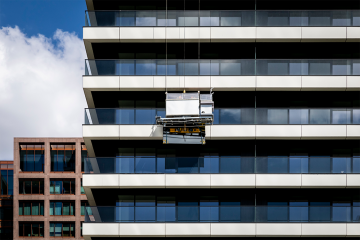As tall buildings have achieved greater heights and their designs have become more complex, the challenges of facade access and maintenance have grown exponentially. There is an increasing need to ensure that facades are properly cleaned and maintained to effectively preserve a building’s function and value to owners and tenants for years to come.
This article looks at the best practices for facade management.
Building Design Considerations
From its conception, the design for a building should consider the need for safe and accessible facade access. This includes the provision of adequate fall protection systems and access routes.
Collaboration with stakeholders
Building owners or developers should collaborate with facade access specialists, architects, and builders to understand the design process and how an efficient facade access system is integrated into a building. Owners and developers should also work closely with contractors to ensure they understand the full scope of work and that any operators of the facade access equipment are trained in the safe operation of the systems. This is especially important on construction sites where multiple trades can be working in very close proximity to the equipment.
Regular inspection
Regular inspections of building facades, roofs, and other structures should be performed to identify potential safety hazards and maintenance requirements for the safety of building occupants and avoid costly property damage. These inspections should be conducted by qualified professionals with experience in identifying issues that may compromise the structure or its ability to withstand expected loads.
Equipment maintenance
Regular maintenance is an essential part of the facade management process. All facade access equipment, including building maintenance units, platforms, ladders, and rope access equipment, should be regularly maintained to ensure optimal operation and enhanced safety. All maintenance and repairs should be performed by appropriately trained professionals and carried out in accordance with the manufacturer’s recommendations in the O&M Manual.
Record keeping
Accurate records should be kept of all works carried out in relation to the facade access equipment, including inspections, maintenance, and repair work. All documentation should include the date and time of each activity, and be signed by an authorised person responsible for the work.
Emergency planning
Emergency plans are essential for ensuring the safety of building occupants the façade access equipment operators and the general public. The emergency plan should be developed through consultation with relevant building stakeholders and the facade access specialists, the Duty Holder and the operators of the equipment should be trained on the Emergency rescue plans, and the Duty Holder should ensure they are readily available in case of such an event.
Risk assessment
Before any work is carried out on the facade, an assessment of the potential risks associated with access such as adverse weather conditions should be carried out to determine the most appropriate time to use the Facade Access equipment for maintenance tasks. This will enable you to identify all potential hazards and take the necessary precautions to carry out any work in a safe manner.
Training
To ensure on-site safety, all employees involved in facade access-related activities must be trained in safe work practices, equipment operation and maintenance, and emergency procedures. In addition to their initial training, they should receive regular refresher training to ensure they are up to date with the latest industry regulations and any changes to the equipment or on the building itself. All trained personnel should receive a training certificate endorsed by the authorized training instructor, and documentation of such training should be filed with the Duty Holder onsite.
Safety Standards Compliance
Building owners and facility managers must ensure that all facade access equipment complies with relevant safety standards and regulations in their region. It is important that the equipment undergoes routine inspections and maintenance in-line with the manufacturer’s recommendations to ensure the systems are running safely and optimally.
By implementing these best practices, building owners and managers can ensure the safe and efficient operation of their facade access systems and protect the safety of operators, building occupants and the public. Get in touch with our experienced team to discuss your facade access requirements.
Back to News